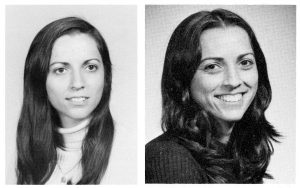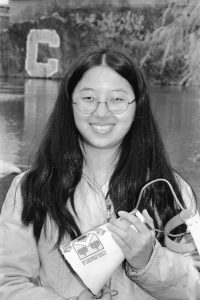Columbia College did not admit women students until 1983 for its first coeducational class, the Class of 1987. But that did not mean that there were no women undergraduate students at Columbia. Both the School of Engineering and General Studies were already co-ed. And in the 1970s, three women engineering students were claiming firsts and leading the path towards coeducation.
First woman graduate from Columbia College

In May 1975, Anna Kornbrot became the first undergraduate woman student to graduate from the then-all-male Columbia College. A student in chemical engineering, Kornbrot pursued the 4-1 program that allowed engineers who graduated from the 4-year BS program to complete a BA in one extra year at the College. When she applied during her junior year, there was no mention in the bulletin about the student’s gender. According to the College Dean Peter Pouncey, there “was a long interlude of bureaucratic haggling and delay,” but he praised Kornbrot’s “impressive character … who with great patience and clearsightedness awaited the inevitable outcome.” Kornbrot SEAS 1974, CC 1975 became the first woman student to graduate from Columbia College but also the last for a while. By the following year, the program was changed: engineering students could still pursue the 4-1 option, but women students would complete their BAs at Barnard College. All of this, for a program that was not particularly popular: only about 10 students had pursued the option.
First woman Lion

Just a few months later, in December 1975, bioengineering freshman Annemarie McCoy SEAS 1979 became the first woman to compete on a Lions varsity team. As a high school student, McCoy was a veteran swimmer in the Amateur Athletic Union. When she arrived at Morningside Heights, McCoy planned to swim for Barnard. However, Barnard told her that only Barnard students could join their swim team. McCoy then approached Columbia swimming coach Don Galluzzi who quickly welcomed her. “My inclination is to let anyone on the team who wants to work at swimming.” As he explained to Columbia Today, “her request was supported by the recently passed Title IX, a federal law prohibiting discriminatory athletic eligibility.” [1] At the time, there were not enough women at Columbia to field a women’s team. The Engineering School had only 80 women students out of 777 student undergraduates and General Studies women generally did not meet NCAA residency and attendance requirements. Therefore, McCoy competed with and against the men in varsity teams. And while she didn’t win any races, her times improved.
First woman Varsity “C” athlete

The following fall, in October 1976, chemical engineering freshman Wendy Ho SEAS 1980 wrote in the Spectator about the discrimination against women engineers. While academic courses were cross listed between Columbia and Barnard, and there were joint music groups and joint political and social organizations, athletics were kept distinctly separate: “Barnard doesn’t let us join their teams and Columbia has no women teams.” Ho found herself in exactly the same situation as McCoy, and like McCoy, Ho was not deterred. She went on to join a Columbia men’s varsity crew team. As a coxswain on the lightweight crew team, Ho became the first woman athlete to receive a Varsity “C” in 1980. Other women had received varsity letters as managers, but Ho was the first to receive one as a competitor.
[1] Tucco, Terry. “Annemarie McCoy: Competing for the varsity.” Columbia Today, June 1976, 44-45.
